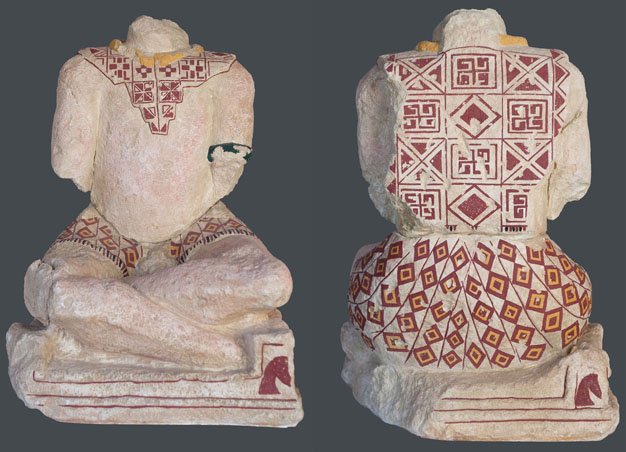Celto-Ligurian God or hero from Glanum covered in symbols and swastikas 5th-2nd C. BCE
"Glanum (Hellenistic Γλανόν, as well as Glano, Calum, Clano, Clanum, Glanu, Glano) was an ancient and wealthy city which still enjoys a magnificent setting below a gorge on the flanks of the Alpilles mountains. It is located about one kilometre south of the town of Saint-Rémy-de-Provence.
Originally a Celto-Ligurian oppidum, it expanded under Greek influence before becoming a Roman city. As it was never built over by settlements after the Roman period but was partly buried by deposits washed from the hills above, much of it was preserved. Many of the impressive buildings have been excavated and can be visited today.
Between the 4th and 2nd centuries BC, the Salyens, the largest of the Celto-Ligurian tribes in Provence, built a rampart of stones on the peaks that surrounded the valley of Notre-Dame-de-Laval, and constructed an oppidum, or fortified town, around the spring in the valley, which was known for its healing powers. A shrine was built at the spring to Glanis, a Celtic God. The town grew, and a second wall was built in the 2nd century BC.
The town had a strong Celtic identity, shown by the names of the residents (Vrittakos, Eporix, Litumaros); by the names of the local Gods (Glanis and his companions, the Glanicae, (similar to the Roman Matres); and the Goddesses Rosmerta and Epona); by the statues and pottery; by the customs, such as displaying the severed heads of enemies at the city gate; and by the cooking utensils found in the ruins, which showed that the people of Glanis boiled their food in pots, rather than frying it in pans like other Mediterranean tribes.
The people of Glanum were in early contact with the Greek colony of Massalia, present day Marseille, which had been founded in about 600 BC. The contact influenced the architecture and art of Glanum – villas were built in the Hellenic style. But by the 2nd century BC conflicts and wars arose between the Salyens and the Greeks of Marseille, who not having a powerful army, called upon the assistance of their Roman allies. In 125 BC the Salyens were defeated by the army of the Roman consul Marcus Fulvius Flaccus, and the following year decisively defeated by C. Sextus Calvinus. Many of the old monuments of Glanum were destroyed.
Due to its commercially useful location on the Via Domitia, and the attraction of its healing spring, the town prospered again. The city produced its own silver coins and built new monuments. The prosperity lasted until 90 BC when the Salyens again rebelled against Rome. The public buildings of Glanum were again destroyed. The rebellion was crushed this time by the Consul Caecilius, and the remains of the main buildings demolished and replaced by more modest structures."
-taken from wikipedia
...
This statue of a hero sitting cross-legged was probably part of a heroic and votive shrine.
The character must have been elevated and surrounded by painted steles. This shrine was destroyed and the statue reused for the construction of the surrounding wall, on the southern side of the bouleuterion. It was indeed discovered in its foundations. It therefore dates from the pre-Hellenic period.
"The statue is deprived of its head; in its current state it measures 0.8 m. in height; the character is sitting cross-legged in a Buddhist pose, on a base finished at the corners by an acroterion. A sealing mortise has been dug under the base.
The God or hero is dressed in a body-clinging tunic stopping at mid-thigh, but open in front to reveal the genitals; a kind of cope is draped over his shoulders closing in a low-cut point on his chest, while it covers his back with a thick square scapular; the collar is open and decorated with the Gallic torque. The left arm is decorated with a bracelet above the elbow, the bent forearm is missing; his hand was resting on an object (head?), which has disappeared and whose remains can be seen on the knee; the right arm is cut off at the elbow.
The simultaneous dismemberment of these sculptures, reused in the same foundation, whether in capitals or the statue, reflects the removal of these materials to a common source, which can only be the ruins of a whole whose cultural role is attested by the presence of the crouching man; the latter characterising, with pillars for cut heads, reused at the same time as the sculptures, the Salluvian sanctuaries whose historically known destruction was due to the punitive operations carried out, at the request of Marseille, by the Romans in 125-124 BC".
Rolland Henri. Hellenistic sculptures found at Glanum. In: Comptes rendus des séances de l'Académie desInscriptions et Belles-Lettres, 112th year, N. 1, 1968
-taken from site-glanum link below
 |
| Celto-Ligurian God or hero from Glanum covered in symbols and swastikas 5th-2nd C. BCE. Paint restored. The swastika symbol is found, in different forms, on both the front and back of the tunic. |
 |
| The statue as it appears now. |
 |
Source:
http://www.site-glanum.fr/en/Explore/Works/Crouching-man#
http://lieuxsacres.canalblog.com/archives/glanum__13_bouches_du_rhone_/index.html
https://de.wikipedia.org/wiki/Datei:Glanum_Keltenfigur.jpg
https://de.wikipedia.org/wiki/Datei:Glanum_Kelte.jpg
Quote:




Comments
Post a Comment